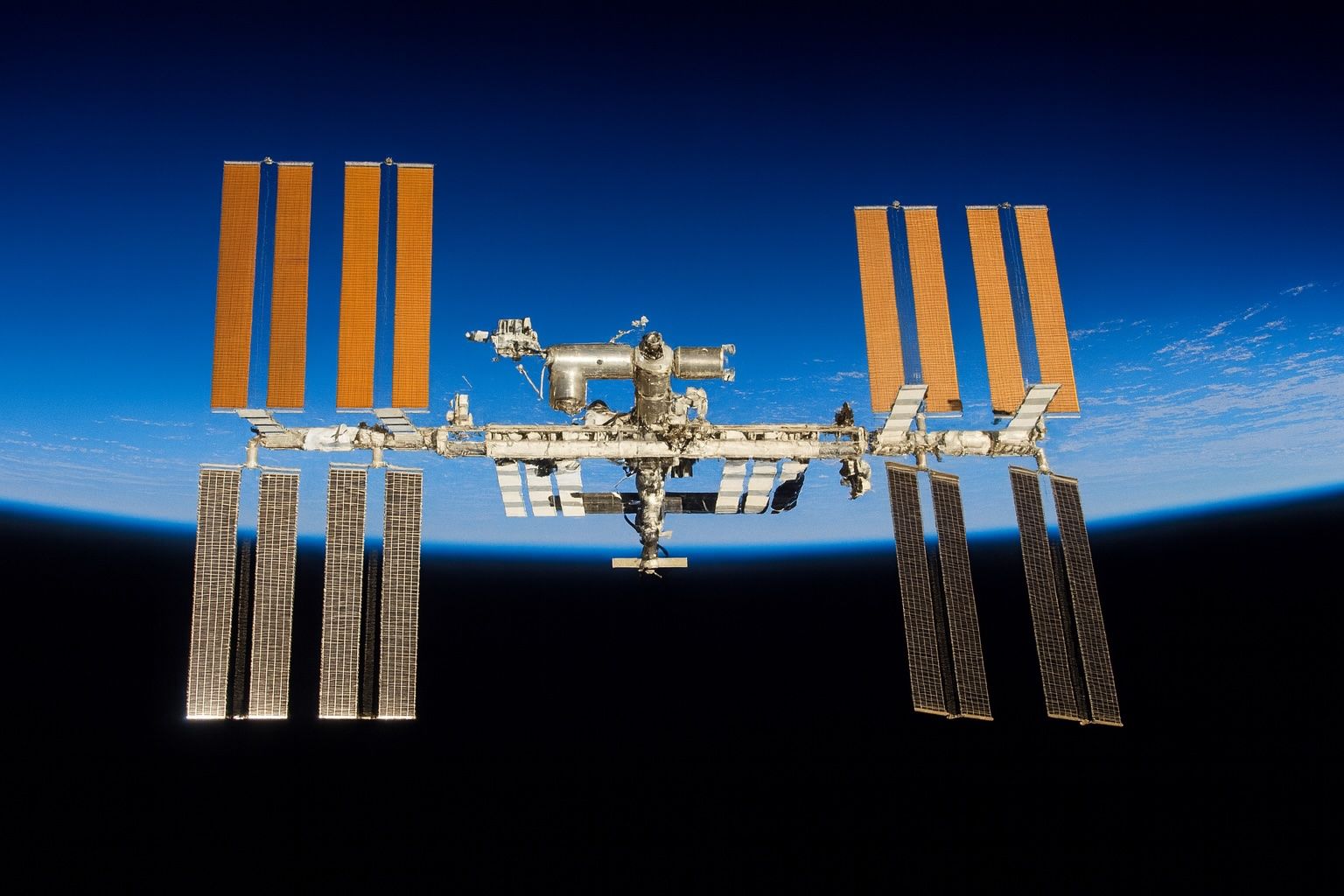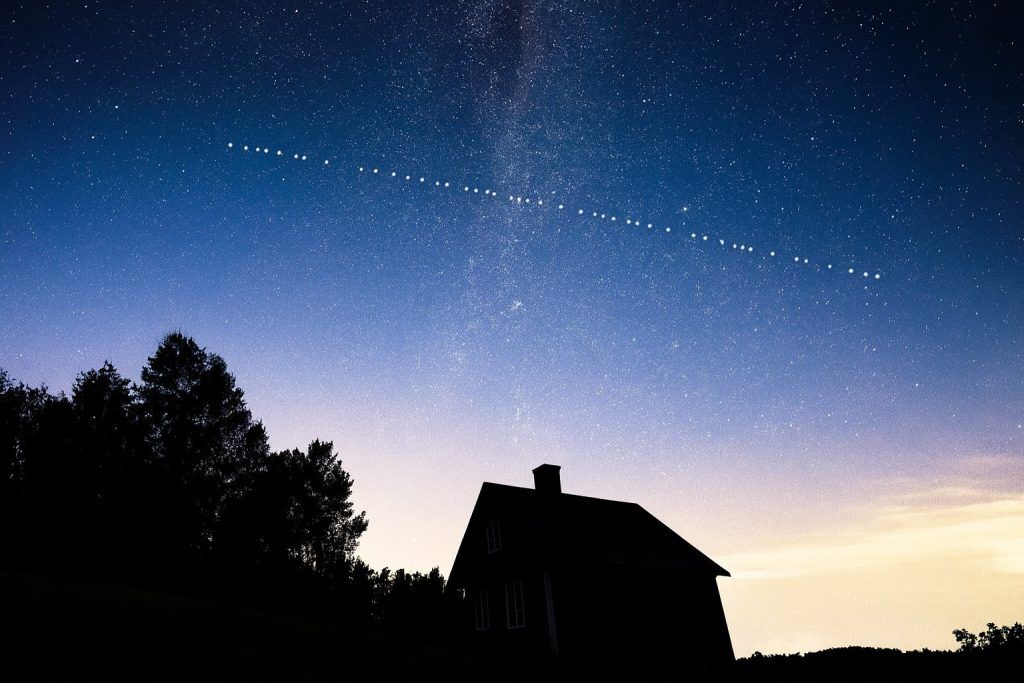- The ISS is roughly football-field-sized, sits about 250 miles above Earth, travels at about 17,500 mph, and completes an orbit every ~92 minutes, circling Earth about 16 times per day.
- Its orbit is inclined about 51.6° to the equator, so its ground track passes over more than 90% of Earth’s population and it never goes farther north than 51.6° N or south than 51.6° S.
- It shines by reflected sunlight, is often the third-brightest object after the Sun and Moon, appears as a steady white dot with no blinking, and can flare slightly when sunlight glints off its solar panels.
- It can be seen only around dawn or dusk when the Sun can illuminate it while the ground is dark, and passes last about 1–2 minutes up to 5–6 minutes if high in the sky, disappearing when it enters Earth’s shadow.
- The ISS travels generally west-to-east, and can appear from the northwest, west, or southwest, with prediction tools telling you where it will appear and disappear.
- NASA’s Spot the Station is available as a website and the free mobile app (iOS and Android), providing upcoming sighting times, maximum elevation in degrees, directions, and alerts, and it retired email alerts in June 2025 in favor of app notifications.
- Heavens-Above and ESA’s Where is the ISS? live map are popular trackers; ESA lists speed about 28,800 km/h and altitude about 400 km, while the ground track helps visualize when it’s near you.
- Live video feeds from the ISS include NASA’s ISS Live stream and NASA+ (launched in 2023), with the August 1, 2025 Crew-11 launch carrying Zena Cardman, Mike Fincke, Kimiya Yui, and Oleg Platonov for a six-month stay arriving the next day.
- Axiom Mission 4 (Ax-4) launched June 25, 2025, carrying astronauts from India, Poland, and Hungary led by Peggy Whitson on a 14-day commercial mission with 23 outreach events.
- The ISS’s 25th anniversary is celebrated in November 2025 (continuous human presence since November 2000), and NASA contracted SpaceX in 2024 to develop a deorbit vehicle for controlled re-entry around 2030–2031, with Russia staying through 2028 and other partners planning operations through 2030.
Introduction: A Space Spectacle in Your Backyard
Have you ever noticed a bright, fast-moving “star” gliding silently across the twilight sky? Chances are, you were watching the International Space Station (ISS) – a football-field-sized science lab orbiting ~250 miles above Earth. Spotting this orbital outpost is easier than you might think, and it’s completely visible to the naked eye when conditions are right [1] [2]. In fact, the ISS is often the brightest object in the night sky after the Moon – a shining white dot that doesn’t blink or change direction like an airplane [3]. As NASA’s ISS director Robyn Gatens says, “Even after 23 years of continuous human presence aboard the International Space Station, it’s incredibly exciting to see the station when you look up at just the right moment… [it] really isn’t that far out of reach.” [4]. This guide will show you how to watch the ISS from Earth, including when to look, where to look, and which apps and tools can send you alerts so you never miss a flyover. We’ll also explain what you’re seeing when you spot the ISS, ways to follow live ISS video streams, and the latest ISS news as of August 2025 – from upcoming missions to public outreach events – all in a friendly, down-to-earth way. Let’s get you looking up! 🚀👀
What Is the ISS and Why Can We See It?
The International Space Station is the largest human-made object in space – roughly the size of a football field – and has been continuously inhabited by rotating crews of astronauts since November 2000 [5]. It zips around Earth at about 17,500 mph (28,000 km/h), completing an orbit every ~92 minutes [6]. That means the ISS circles Earth 16 times per day, giving its crew a sunrise and sunset every 45 minutes [7]! The station’s orbit is tilted about 51.6° to Earth’s equator, so its ground track passes over most of the inhabited world – NASA notes it “passes over more than 90% of Earth’s population” during its flights [8]. However, it never goes farther north than roughly 51.6° N or south than 51.6° S latitude, so people nearer the poles won’t see it directly overhead (if you live beyond ~52° latitude, the ISS will stay near the horizon at best) [9].
Why is the ISS visible at all? Simply put, it shines by reflected sunlight. The station’s giant solar panel arrays and metallic modules act like mirrors, glinting sunlight down to us. Just as the Moon is visible by reflecting the Sun’s light, the ISS is visible for the same reason [10]. When the geometry is right, it can appear astonishingly bright – often outshining all stars and planets in the sky [11]. In fact, on a good pass the ISS can be the third-brightest object in the sky (after the Sun and Moon) [12], easily seen even from light-polluted city centers [13]. To the naked eye it looks like a steady, non-twinkling bright point moving across the sky. Unlike airplanes, it has no flashing lights and it won’t change course or speed – it glides in a smooth arc at a constant speed, covering the sky in a matter of minutes [14]. Many first-time observers mistake it for a low-flying plane until they notice the ISS doesn’t blink or make any sound. “The lack of flashing lights is the easiest way to tell that it is the ISS and not an airplane,” one astronomy writer explains [15]. So if you see a brilliant white dot steadily trekking across the stars, you’re probably watching the ISS – and yes, there are people aboard that moving “star”! 👋
When Is the ISS Visible? (Timing & Conditions)
Timing is everything when it comes to spotting the space station. The ISS is not visible all the time, because you can only see it when it’s reflecting sunlight and you are in darkness. This usually means looking within a few hours after sunset or before sunrise – the sweet spots when your sky is dark but the Sun can still reach the station high above [16] [17]. NASA emphasizes that the ISS “can only be seen when it is dawn or dusk at your location”, since it isn’t bright enough to show up against broad daylight [18]. In the middle of the night, the ISS often falls into Earth’s shadow (i.e. it’s in darkness too), so it disappears from view. If you’ve ever watched a bright ISS pass suddenly fade out, that’s exactly what happened – the station moved into Earth’s shadow (no sunlight = no shine) [19]. Conversely, an evening pass may suddenly pop into view partway across the sky when the ISS exits Earth’s shadow into sunlight. These disappearances/appearances can be startling if you aren’t expecting them!
For an ISS sighting to occur, two things must line up: (1) The station’s orbit must carry it over your region at the right time, and (2) it has to be around dawn or dusk for you. Due to the ISS’s frequent orbits and Earth’s rotation, most locations get multiple viewing opportunities each month. On average, viewing conditions are favorable several times a month at a given spot [20]. In practice, you might get a flurry of good sighting opportunities over a week or two, then a gap of no passes for a while. NASA explains that “it can range from one sighting a month to several a week” depending on orbital alignment [21]. During some periods the ISS might appear on consecutive nights, or even twice in one night, as it makes back-to-back orbits that are visible. At other times, weeks could pass without a convenient flyover – it all depends on the orbital phasing. Don’t worry; any gaps are temporary as the ISS orbit continuously shifts relative to Earth’s day/night.
How long and bright is a typical sighting? That can vary. Each pass might last anywhere from about 1-2 minutes (short skim near the horizon) up to 5-6 minutes (a full high pass overhead). The higher the ISS goes in your sky, generally the longer and brighter the appearance. Some shallow passes are so low they stay dim or get obscured by trees/buildings, whereas an overhead pass on a clear night can shine incredibly bright – often “brighter than the brightest stars or planets” [22]. For best results, try to catch passes that reach a high elevation (the prediction tools will list this) and occur in full darkness on the ground. Those tend to be the most spectacular. Of course, weather is a factor – a clear sky is essential. Even thin clouds or haze can hide the ISS, so check your local forecast (some apps even include “astronomy weather” forecasts [23] for planning). The good news is the ISS is bright enough that a little light pollution isn’t a deal-breaker; city dwellers can see it just fine as long as the sky is clear [24]. Just try to avoid standing under glaring streetlights that might ruin your night vision.
What direction should you look? The ISS always travels generally west-to-east (since it orbits in the same direction Earth rotates), but it might approach from the northwest, west, or southwest part of your sky depending on the orbit track. Tracking websites will tell you exactly where it will “appear” and “disappear” (e.g. “appears 10° above W horizon, disappears 20° above SE horizon”). A simple rule: start by looking toward the part of the sky where the Sun set (west) for evening passes or where the Sun will rise (east) for morning passes, since the station will enter sunlight from that direction. As it comes into view, you’ll see that bright dot steadily moving, and you can follow it as it arcs across the sky. A typical pass goes from one horizon to the opposite, or sometimes it will start/stop partway through the sky when the ISS enters/exits Earth’s shadow. Remember, it’s moving fast – crossing the sky in a few minutes – so be on time! If the prediction says 9:05 pm, be looking by 9:03. A minute or two lateness can make you miss it. Fortunately, the tracking tools and alerts in the next section will help ensure you’re looking at the right place at the right moment.
How to Track the ISS – Websites, Apps and Alerts 🔭📱
You don’t have to guess when or where the ISS will fly over you – there are excellent (and free) tools that will do all the work. Here are some of the top websites and mobile apps to help you track the ISS and get viewing alerts:
- NASA “Spot the Station” – Official Website & App: NASA’s own ISS tracking service is called Spot the Station. On the website, you can select your city (or coordinates) and see a list of upcoming sighting times for the next few weeks [25]. NASA’s tool will tell you exactly what time the ISS will appear, how long it will be visible, how high it will get (in degrees above the horizon), and the compass directions where it will appear/disappear [26]. Until mid-2025 you could even sign up for email or text alerts, but note that NASA retired the email alert system in June 2025 in favor of a new mobile app [27]. The good news is the free Spot the Station smartphone app (available on iOS and Android) has even more features [28]. You can enable push notifications that ping your phone whenever an ISS pass is coming up over your exact location [29], so you’ll never miss one. The app also includes a cool augmented reality (AR) sky compass – hold up your phone and it will show you where the station will travel across your sky, making it easier to locate [30]. NASA developed this app to make ISS spotting easy and fun for the public, explaining that it expands on the trusted Spot the Station website with real-time tracking, AR visuals, and even the ability to capture and share photos of your sightings [31]. (Insider tip: NASA’s email alerts (when they existed) would only notify you for the really good passes – those higher than 40° above the horizon [32] – to avoid bothering you with low-quality sightings. The app lets you customize notifications, but focusing on higher passes is still wise for the best experience.)
- Heavens-Above: A popular third-party website (and app) used by amateur astronomers, Heavens-Above provides highly accurate satellite tracking data. You can input your location and get detailed ISS pass predictions with star charts showing the exact path. It’s a bit more technical-looking, but very reliable. Many ISS enthusiasts use it for its precision. (No official citation here, but it’s widely recommended in the astro community.)
- ESA’s “Where is the ISS?” Tracker: The European Space Agency offers a neat live map that shows the ISS position in real time [33]. On ESA’s tracking page you’ll see a world map with the station’s ground track, updated constantly. It also displays the ISS’s speed (~28,800 km/h) and altitude (~400 km) as it orbits [34]. This is great for visualizing the ISS orbit and knowing when it’s getting close to your part of the world. (It’s not an alert service, just a real-time tracker.) The ESA page reminds us that the station appears to move west-to-east and that it shifts westward on each orbit due to Earth’s rotation [35] – pretty fascinating! You can check this map to watch the ISS approach your longitude, then step outside at the time your local prediction gave.
- Mobile Apps (Other): In addition to NASA’s official app, there are several excellent third-party smartphone apps for ISS observers. For example, “ISS Detector” (Android) and “SkyView” / “Night Sky” (iOS/Android) are apps that will alert you to ISS passes and even show you where to look with a phone AR view. Many general stargazing apps (like SkySafari, Stellarium, etc.) also include ISS tracking. These apps tap into the same orbital data and can be very handy if you prefer a specific interface. Just make sure to allow location access and notifications. (Pro tip: Set an alarm a few minutes before the pass time – it never hurts to have a backup reminder!)
- Astronomy Websites & Newsletters: Science news outlets often alert readers to especially noteworthy ISS events. For instance, if the ISS will make an unusually bright pass over a major city or pair up with another object (like occasionally you can see it transit near the Moon or Venus), you might see a headline about it. Following NASA, ESA, or space news sites on social media can sometimes give you a heads-up. But for routine daily tracking, stick to the dedicated tools above or sign up for alerts via app.
In short, use technology to your advantage. As one guide put it, “There are many websites and cell phone apps that can notify onlookers when the ISS will be visible”, with NASA’s Spot The Station being a prime example [36]. With an app in your pocket buzzing you at ISS o’clock, you can simply step outside and enjoy the show!
What Are You Seeing? – Understanding an ISS Flyover
It’s worth pausing to appreciate what that shiny moving dot really is. When you watch the ISS, you’re seeing a habitable spacecraft the size of a house moving at 5 miles per second (!) crewed by astronauts from around the world. On board, typically 7 people are living and working – conducting science experiments, exercising, even eating dinner – as that “star” cruises overhead. The station’s appearance as a steady light is because from our distance (~400 km down), we cannot resolve its shape with the naked eye; it’s too small angularly. Through a telescope or good binoculars you might just make out a tiny H-shaped form (the solar panels extending from the truss). But without magnification, it’s a point of light. The color often looks white or yellow-white. Sometimes people report it flares or flickers slightly – that can happen if the orientation changes or if sunlight glints off reflective surfaces differently. Overall, it usually maintains a constant brightness during the central part of the pass, then fades as it enters shadow.
One amazing aspect is that when you’re watching the ISS, it’s also watching you – or at least, it’s taking photos of Earth below. The astronauts aboard often photograph cities at night, auroras, and lightning storms. They’ll sometimes comment that knowing people are waving up at them is inspirational. (Follow astronauts on social media and you may see them post, “Hello to everyone who saw the ISS tonight over Europe!”) It creates a lovely human connection: that bright speck holds our fellow humans, working in microgravity to advance science. NASA notes the ISS has become a “blueprint for science, exploration, and partnerships in space for the benefit of all” on Earth [37]. So, when you point it out to your friends or kids, be sure to mention “There are people up there!” – it never fails to awe.
During a pass, what you’re physically seeing is sunlight reflecting off the station’s surfaces. The ISS has huge solar panels (~110 feet/34 m long each) angled to the Sun, which act like mirrors. It also has a white hull and radiators. All of these catch sunlight and beam it down to us. This is why brightness can vary with angle – the more directly the sunlight bounces toward your location, the brighter the station looks. Occasionally, you might witness an ISS solar panel flare (similar to Iridium satellite flares of the past) where it brightens even more for a few seconds if the angle is perfect. And as mentioned, once the ISS goes into Earth’s shadow (night), it’s like someone turning off the bulb – it vanishes even though it’s still up there. The station doesn’t produce any visible light on its own (its exterior lights are too faint to see from the ground), so no sunlight means no sighting [38].
If you’re curious which ISS module or part you might be seeing – with unaided eyes, it all blurs into one point of light. But advanced hobbyists have photographed the ISS through telescopes, revealing its T-shape and even docked spacecraft. There are plenty of images online showing what the ISS actually looks like zoomed in (it’s worth a Google!). For most of us, though, the thrill is simply knowing that moving star is a high-tech research outpost with humans aboard. It’s a great conversation starter and a way to feel connected to space exploration from your backyard.
Beyond Viewing: Live Streams and Following ISS Activity
Watching the ISS fly over is exciting, but you can also follow the space station’s adventures in other ways – from live video feeds to interactive experiences. Here are some ways to stay engaged with the ISS beyond just spotting it in the sky:
- Live Video from the ISS: Ever wanted to see what the astronauts see? There is usually at least one live camera feed from the ISS beaming back to Earth 24/7. NASA runs an “ISS Live” stream (often available on YouTube or the NASA website) that shows either a live view of Earth from the station or inside views when available [39]. The scenery can be breathtaking – you’ll watch Earth’s curved horizon, clouds, oceans, and city lights rolling by from the ISS perspective. Sometimes the feed goes dark when the station is in nighttime, but when it’s in daylight the imagery is stunning. (Pro tip: Pairs perfectly with music for a relaxing experience!) Occasionally you’ll also hear audio from NASA Mission Control and the astronauts in the background during these live feeds [40], giving you a fly-on-the-wall experience of spaceflight operations. To find the live feed, check NASA’s “ISS Live” webpage or search “ISS live stream” on YouTube – the official stream is freely available. Keep in mind the video is a few seconds delayed and can cut out (the ISS transmits via satellite link to Houston), but it’s a real-time peek at Earth from ~400 km up.
- NASA TV / NASA+ (ISS Coverage): NASA provides coverage of major ISS events – such as spacecraft dockings/departures, spacewalks, and crew interviews – through NASA Television and the new NASA+ streaming service. For example, when a crew launch or cargo ship is arriving at the ISS, NASA will broadcast the rendezvous and docking live, with commentary. In fact, for the recent Crew-11 mission in August 2025, NASA’s new NASA+ service started streaming coverage at 1:00 a.m. for the docking at 3:00 a.m. [41]. NASA+ (launched in 2023) is a free online platform where you can watch NASA TV and exclusive series – it’s available via the NASA app or web browser. So if you’re hungry for more than just a naked-eye sighting, tune into NASA’s feeds to watch the astronauts in action. You might catch a spacewalk where two crew members float outside the station, or a live tour of the ISS, or an educational event.
- Interactive ISS Experiences: The European Space Agency (ESA) has created a wonderful interactive 3D virtual tour of the ISS [42]. You can explore inside the station’s modules, looking around in 360° as if you were an astronaut floating through the corridors. This can be found on ESA’s website (a link is provided on the Canadian Space Agency’s ISS page) [43]. It’s a great way to visualize the interiors – how cramped (or surprisingly roomy) some sections are and where astronauts work, sleep, and exercise. Additionally, various museums and science centers have ISS replicas or VR experiences that let you “experience” the ISS. NASA’s Destination Station traveling exhibit, for instance, toured various cities to educate the public about ISS science and even had a mock-up module to walk through [44]. Keep an eye out for such events in your area – they are often free and family-friendly.
- ISS News and Social Media: For real-time updates and behind-the-scenes looks, follow the official ISS social media accounts. NASA’s @Space_Station account on X (Twitter) and Instagram posts daily about what the crew is doing, often sharing spectacular photos taken from the station (city lights at night, auroras, etc.). The astronauts themselves often have accounts – for example, NASA astronaut Mike Fincke and others share personal insights. In 2025, astronaut Sultan Al Neyadi from UAE made headlines by sharing stunning night photos and even live chats during his ISS mission. NASA also maintains a Space Station blog with daily reports on crew activities, science experiments, and any technical happenings on board [45]. By following these sources, you go from just seeing the ISS to really understanding what’s happening on it.
- Ham Radio and Calls: One unique way space enthusiasts connect with the ISS is via amateur radio. The ISS has a ham radio station on board, and through the ARISS program (Amateur Radio on the ISS) astronauts schedule brief radio contacts with schools and ham operators worldwide. If you’re a licensed ham radio operator, you can attempt to listen in or even contact the ISS when it passes overhead (they operate on specific frequencies). For the general public, some contacts are broadcast at schools or science centers as outreach. It’s pretty amazing to hear an astronaut’s voice live from space answering students’ questions! In August 2025, for example, NASA astronauts Mike Fincke and Zena Cardman participated in an educational downlink, answering STEM questions from students in Minnesota via an Earth-to-space Q&A session [46]. Events like these are often streamed or posted online after, and they illustrate how the ISS crew actively engages with communities on Earth. Keep an ear out (or check NASA’s schedule) for such “Amateur Radio on ISS” events if you’re interested.
In summary, once you’ve caught the “ISS bug” by seeing it in your sky, there are plenty of ways to feed that interest: watch live views from orbit, follow the missions on NASA/ESA media, or even interact through special events. It’s never been easier to feel connected to our orbiting home in space.
Latest ISS News & Upcoming Events (as of August 2025)
The year 2025 has been an exciting time for the International Space Station program, with new missions and milestones that might interest ISS watchers:
- Crew Launches and Visiting Missions: On August 1, 2025, SpaceX Crew-11 blasted off from Florida carrying four crew members – NASA astronauts Zena Cardman and Mike Fincke, JAXA astronaut Kimiya Yui from Japan, and Roscosmos cosmonaut Oleg Platonov from Russia – for a six-month expedition aboard the ISS [47]. They arrived at the station the next day, temporarily bringing the onboard headcount to 11 (until the previous Crew-10 returned home) and continuing the regular crew rotation schedule. Crew-11 will carry out dozens of science experiments (from simulating Moon landings to biomedical studies) during their stay [48]. Their mission reflects the deeply international nature of the ISS even amid global tensions – U.S., Russian, and Japanese astronauts working side by side in orbit.
- Historic International Participation: In summer 2025, a private mission called Axiom Mission 4 (Ax-4) made history by ferrying three nations’ first astronauts to the ISS. This 14-day commercial flight (launched June 25, 2025) included participants from India, Poland, and Hungary, marking the first time those countries sent government-sponsored astronauts to space in over 40 years [49]. Led by former NASA astronaut Peggy Whitson, the Ax-4 crew conducted experiments and 23 outreach events while aboard [50], engaging audiences back home. This mission underscored how the ISS is expanding global access to space. Millions of people in India, Poland, and Hungary looked up knowing one of their own was passing overhead – likely boosting public interest in ISS sightings in those regions. It’s a reminder that the ISS is a worldwide collaboration, and anyone under its path can feel a part of it.
- Public Outreach and Education: NASA and partner agencies continue to use the ISS as a tool to inspire the public. In 2025 there have been numerous live in-flight education events. For example, in August 2025, NASA arranged for astronaut Mike Fincke (on Crew-11) and astronaut-in-training Zena Cardman to answer questions from students in Minnesota via a live Earth-to-space call [51]. Such events let students (and the public) interact directly with astronauts, often broadcast on NASA TV or online. Additionally, the ISS program celebrated its upcoming 25th anniversary of continuous human presence. In fact, November 2025 marks 25 years since the first crew took up residence (in November 2000), and NASA kicked off a “silver anniversary” commemoration highlighting the station’s scientific achievements [52]. A NASA article from August 2025 noted, “This November marks a quarter century of continuous human presence aboard the International Space Station,” emphasizing the ISS’s role as a springboard for future exploration [53]. We can expect public outreach campaigns around this milestone – possibly special programs, documentaries, or social media events inviting people to share their ISS sightings and memories.
- Changes in How to Spot the ISS: One practical update for avid skywatchers: NASA’s transition to the Spot the Station mobile app. As mentioned earlier, in May 2025 NASA announced it would retire the website’s email alert feature and focus on the app for notifying the public about sightings [54] [55]. If you were signed up for emails, you likely received a note about this change. The app has been well-received as a more modern, customizable tool – though some longtime users voiced concern about losing the simple website listings for those without smartphones [56]. Nevertheless, NASA is actively improving the app (which is open-source) and encouraging everyone to use it to continue enjoying ISS flyovers [57]. So far, the shift seems to be working, with thousands of new downloads and people sharing AR screenshots of the ISS’s path on their phone. If you haven’t already, now’s the time to grab the app, since the old email system is no more.
- Visibility News – Seasons and Sightings: There haven’t been any fundamental changes in ISS visibility (it still follows the same orbital pattern), but one thing making news in mid-2025 was the favorable viewing in higher latitudes during summer. In June/July, observers in places like Canada and Northern Europe experienced a period of “continuous twilight” where the ISS could be seen multiple times a night because the Sun never set too far – a phenomenon that often occurs around the solstice. For instance, media in the UK and northern US reported on strings of bright ISS passes in July that were easy to catch given the late evenings. If you live in mid-to-high latitudes, summer can actually afford more frequent sightings (though sometimes at inconvenient wee hours!). Conversely, early August 2025 gave some spectacular evening passes over parts of the U.S. and Canada – Newsweek even ran a story with a map showing where “millions can see the ISS on Thursday night” during a particularly widespread pass [58]. The takeaway: keep an eye on local news or astronomy websites; when especially good sighting opportunities arise (e.g. a bright pass over a major city at 9 PM), it often becomes a mini news item.
- Future of the ISS: Looking a bit beyond 2025, it’s worth noting that the International Space Station is approved to operate through at least 2030. After that, plans are in motion to safely deorbit the station. In fact, in 2024 NASA contracted SpaceX to develop a special “deorbit vehicle” that will help guide the ISS to a controlled re-entry in the atmosphere when the time comes (around 2030-2031) [59]. Several ISS partner agencies (NASA, ESA, JAXA, CSA) have formally committed to keep using the ISS until 2030, while Russia has agreed to stay on through 2028 for now [60]. NASA officials have floated the possibility of extending past 2030 if new commercial space stations aren’t ready yet [61], but either way, we are in the final years of the ISS’s life. That makes each opportunity to see it all the more special – the station’s “golden decade” of the 2020s is a chance for everyone to witness this engineering marvel before it’s gone. NASA’s Ken Bowersox (head of Space Operations) summed it up, saying deorbiting the ISS will be done responsibly while ensuring a smooth handoff to future commercial stations, and he praised the ISS as “the orbital laboratory [that] remains a blueprint for science, exploration, and partnerships in space for the benefit of all.” [62]
In the meantime, the ISS is as active as ever in 2025 – hosting new technology demos, scientific research, and even movie crews (a Russian film crew visited in 2021, and there’s talk of another in coming years). There’s a continuous relay of SpaceX Dragon and Northrop Grumman Cygnus cargo ships keeping it supplied, and possibly Boeing’s Starliner spacecraft may finally join the fleet if its crew test flight succeeds. All this means plenty of human activity 250 miles overhead, which you can literally watch with your own eyes on a clear night.
Conclusion: Look Up and Share the Experience
Watching the International Space Station sail across the sky is a simple pleasure that connects us with something much bigger – the ongoing story of human space exploration. It doesn’t require any telescope or special training, just a bit of timing and the willingness to step outside and look up. As we’ve covered, there are abundant resources to help you know when and where to see the ISS, so you’ll always be prepared for the next pass. Whether you’re a casual stargazer or a parent inspiring a child, that bright dot moving among the stars can spark wonder.
So the next time you get an alert that the ISS is coming over your town, grab your family or friends, head outdoors at dusk, and wave hello to our astronauts on “humanity’s home in space” [63]. You might even make it a habit – many folks love to track each pass and feel a personal connection to the astronauts above. And don’t forget to spread the word: share the experience with others. It’s free, it’s awe-inspiring, and as long as the ISS is up there, the night sky has a moving reminder of what we can achieve together. Happy ISS hunting!
Sources: NASA and ESA official materials, science news outlets
- NASA Spot the Station FAQ – optimal viewing at dawn/dusk [64]
- Space.com – ISS reflects sunlight, brightest object except Moon [65]; orbit covers 90% of population, inclination limits [66]; tracking tools and alerts [67]
- Canadian Space Agency – ISS looks like bright white dot, no blinking, visible even in cities [68]
- AccuWeather – ISS is third brightest object, steady white light (no flashing) [69]; NASA explanation of sunlight reflection and dawn/dusk visibility [70]
- NASA News Release (Nov 2023) – “Look Up: New NASA App Helps Stargazers Spot Space Station” – Quote from R. Gatens on excitement of seeing ISS [71]; Why ISS is visible and when (dawn/dusk, 1/month to several/week) [72]; Spot the Station app features (AR, notifications) [73]; 25th anniversary of ISS mentioned [74]
- NASA Watch (Keith Cowing) – Memo about retiring Spot the Station website features (June 2025) [75] [76]
- NASA Blog (Aug 1, 2025) – Crew-11 launch details (crew members, date) [77]
- Axiom Space – Ax-4 mission summary (India, Poland, Hungary astronauts) [78]
- NASA News Release (Aug 15, 2025) – Continuous human presence 25 years (Silver Jubilee) [79]
- NASA News Release (Feb 2024) – ISS deorbit plans: SpaceX vehicle to deorbit ISS after 2030 [80]; Quote from K. Bowersox on ISS legacy and future [81]
- NASA News Release (Education/Outreach) – Astronauts Fincke and Cardman to answer students’ STEM questions from ISS (Aug 2025) [82].
References
1. www.accuweather.com, 2. www.asc-csa.gc.ca, 3. www.asc-csa.gc.ca, 4. www.nasa.gov, 5. www.accuweather.com, 6. www.esa.int, 7. www.esa.int, 8. www.space.com, 9. www.space.com, 10. www.nasa.gov, 11. www.accuweather.com, 12. www.accuweather.com, 13. www.asc-csa.gc.ca, 14. www.asc-csa.gc.ca, 15. www.accuweather.com, 16. www.nasa.gov, 17. www.nasa.gov, 18. www.nasa.gov, 19. www.accuweather.com, 20. www.accuweather.com, 21. www.nasa.gov, 22. www.accuweather.com, 23. www.accuweather.com, 24. www.asc-csa.gc.ca, 25. www.accuweather.com, 26. www.space.com, 27. nasawatch.com, 28. www.nasa.gov, 29. nasawatch.com, 30. www.nasa.gov, 31. www.nasa.gov, 32. www.space.com, 33. www.space.com, 34. www.esa.int, 35. www.esa.int, 36. www.accuweather.com, 37. www.space.com, 38. www.accuweather.com, 39. www.asc-csa.gc.ca, 40. www.asc-csa.gc.ca, 41. www.nasa.gov, 42. www.asc-csa.gc.ca, 43. www.asc-csa.gc.ca, 44. ntrs.nasa.gov, 45. nasawatch.com, 46. www.nasa.gov, 47. www.nasa.gov, 48. www.nasa.gov, 49. www.axiomspace.com, 50. www.axiomspace.com, 51. www.nasa.gov, 52. www.nasa.gov, 53. www.nasa.gov, 54. nasawatch.com, 55. nasawatch.com, 56. nasawatch.com, 57. nasawatch.com, 58. www.newsweek.com, 59. www.space.com, 60. www.space.com, 61. www.space.com, 62. www.space.com, 63. www.nasa.gov, 64. www.nasa.gov, 65. www.space.com, 66. www.space.com, 67. www.space.com, 68. www.asc-csa.gc.ca, 69. www.accuweather.com, 70. www.accuweather.com, 71. www.nasa.gov, 72. www.nasa.gov, 73. www.nasa.gov, 74. www.nasa.gov, 75. nasawatch.com, 76. nasawatch.com, 77. www.nasa.gov, 78. www.axiomspace.com, 79. www.nasa.gov, 80. www.space.com, 81. www.space.com, 82. www.nasa.gov










